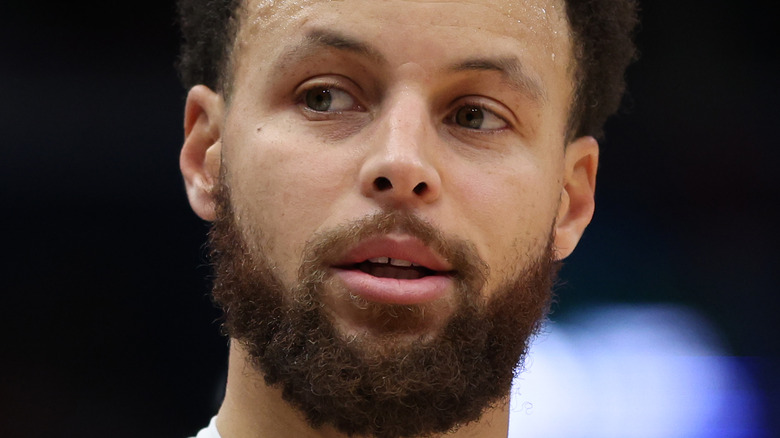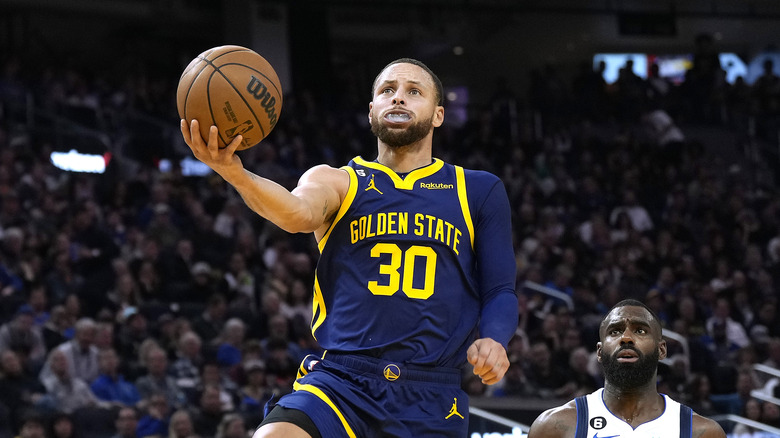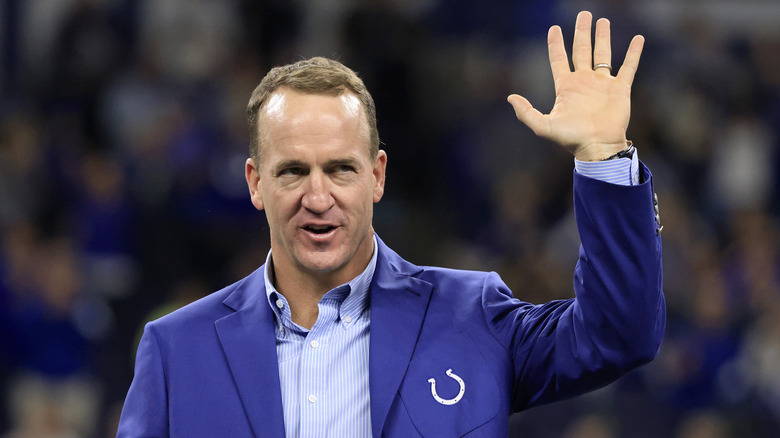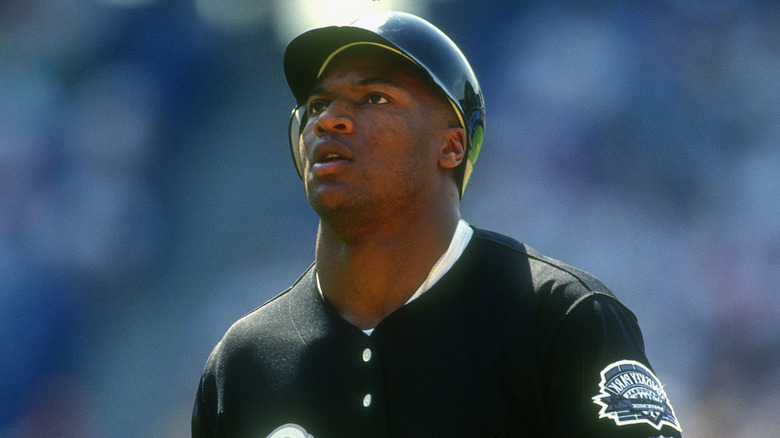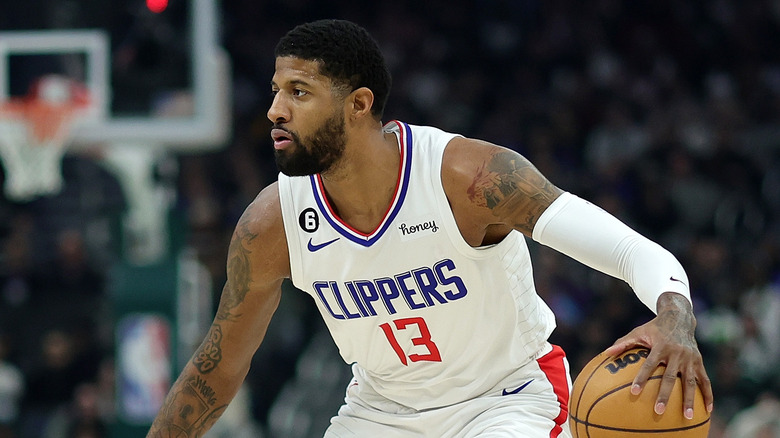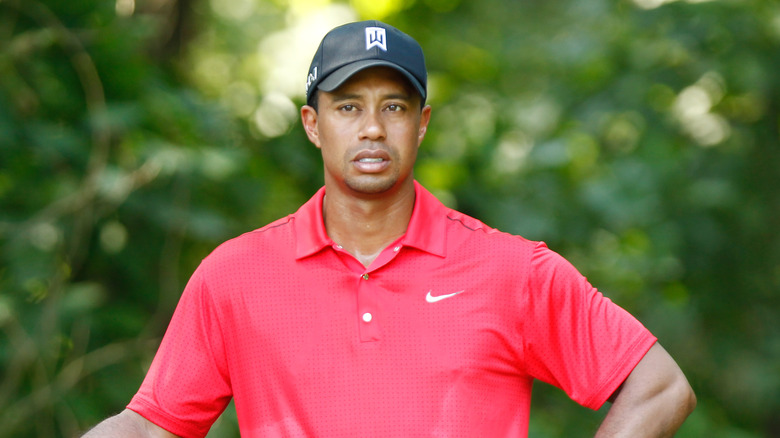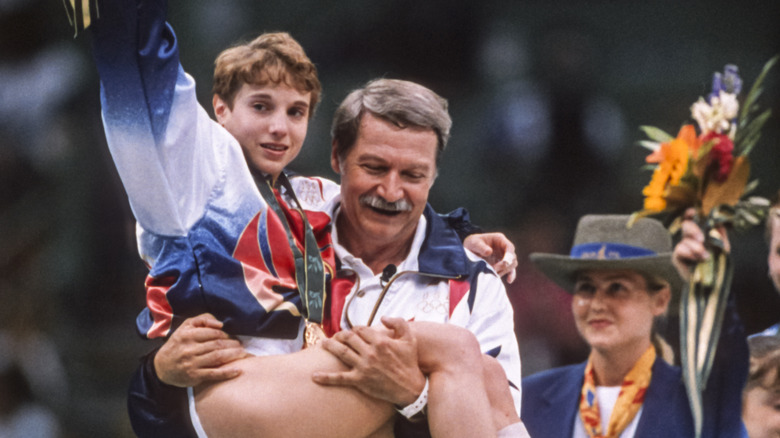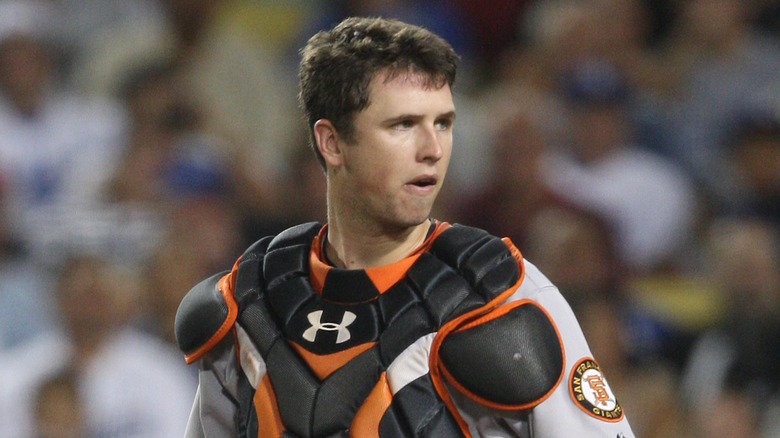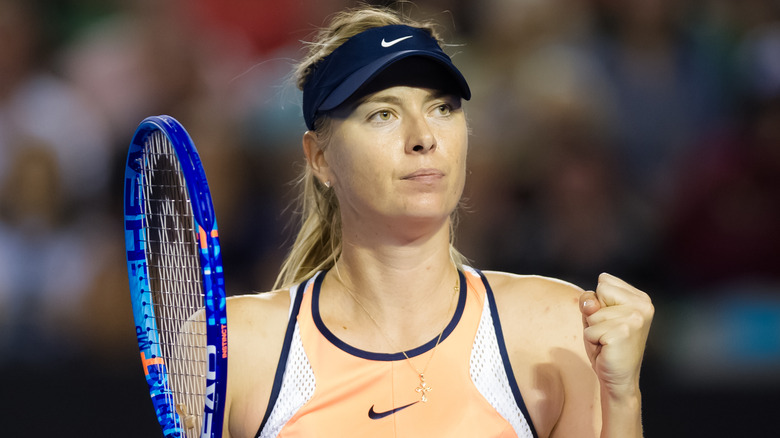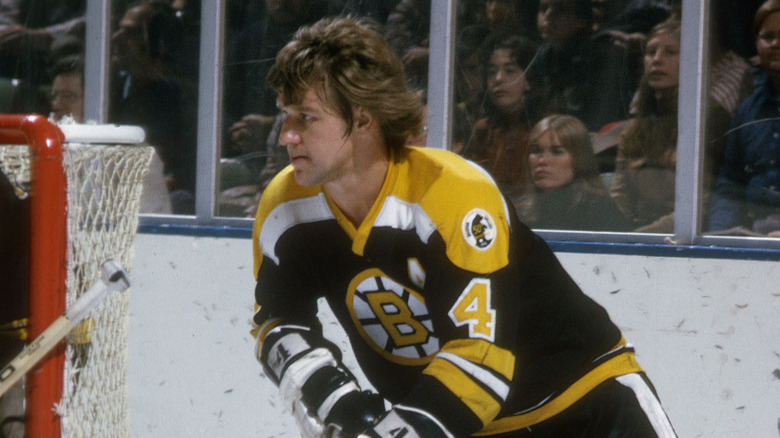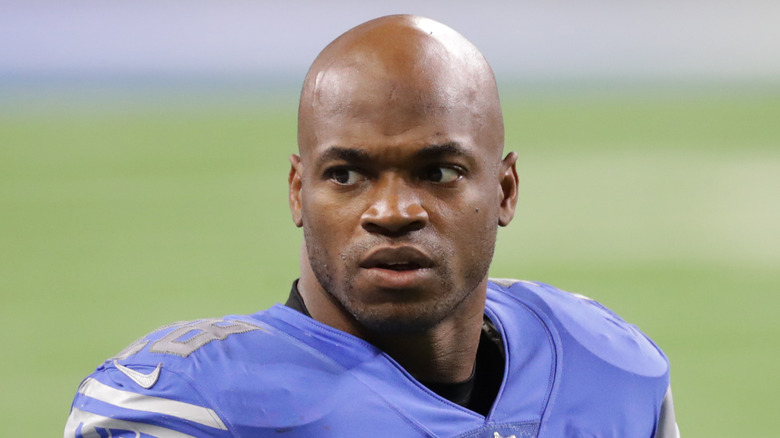Injuries That Rocked Athletes At The Height Of Their Careers
There's no denying the fact that there are tons of perks that come with being a professional athlete — million-dollar paydays, a certain level of celebrity, unique opportunities, access to world-class medical care... the list could go on and on. But it's also true that there are plenty of risks to making sports, and by extension your body, your job. Namely, injuries.
No matter how hard you train or how intentional you are about your prehab, there's always a possibility that you could get hurt on the court. Some injuries have led to further complications and have, sadly, screwed up the careers of many of the world's greatest athletes.
Here, we've rounded up ten stars from a variety of sports who were rocked by injuries at the height of their careers. Some of them, like Peyton Manning, were able to return and play better than they ever had before. Others, like Kerri Strug, were benched permanently by their accidents. Read on to see how many of these painful incidents you remember.
Steph Curry
From the moment Steph Curry swished his first three-pointer as a Golden State Warrior, his name has been tossed around in many a greatest-of-all-time conversation. He is, without a doubt, the best shooter the NBA has ever seen, holding league records for most three-pointers ever made (well over 3,000) and highest true shooting percentage of all time. And in his mid-thirties, there's still plenty of longevity to his career and plenty of records to be broken. If his body will allow it, that is.
In February 2023, during a game against the Dallas Mavericks, Curry suffered a lower leg contusion and tears in several of the ligaments in one of his knees. While Warriors head coach Steve Kerr didn't seem too devastated by the injury — he told reporters, "It's not an injury that's going to keep him out for the season. He's going to come back... hopefully, sooner rather than later" (via CNN) — fans worried that the blow might have a longer-lasting effect than Kerr, or Curry, were willing to admit.
The knee snafu is yet another entry on a full list of injuries the point guard has suffered over the years. And his tendency to wind up with long-lasting impairments (in the same season, he missed 11 games due to a partially dislocated shoulder) has many concerned. But so far, Curry has proven to be resilient, always eager to return to the court in tip-top shape, so we're hopeful this is just another bump in the road rather than a career-ender. After All-Star break, Curry is set to be reevaluated, with a league source hoping he quickly returns.
Peyton Manning
Another greatest of all time contender, former quarterback Peyton Manning also suffered a devastating injury at the height of his career. For a good portion of the 2000s, the NFL player had a herniated disk in his neck that caused him a substantial amount of pain. So in 2011, he underwent a last-ditch attempt to alleviate the suffering — a spinal fusion surgery that, he told The New York Times, his doctor warned him could have ended his career. Thankfully, it never came to that, and he went on to play four more seasons (and win one more Super Bowl) after recovering.
Still, the road to recovery wasn't an easy one for Manning. He wound up sitting out for the entire 2011-2012 season, after which the Indianapolis Colts released him, filling his place with rookie Andrew Luck. Fortunately, the Denver Broncos, who had been in a bit of a drought, snapped him up and were willing to wait out his recovery in the hopes that Manning could help them bring home another title.
Manning also never fully regained feeling in the fingertips on his right hand. He said in 2015 (per Sports Illustrated) that his doctor thought it was unlikely that full feeling would ever come back, which leaves us to wonder if some of the lingering side effects of the injury played any role in Manning's decision to retire in 2016.
Bo Jackson
Bo Jackson is history's only athlete to be named an All-Star in two sports. A professional football and baseball player, he was a running back for the Raiders and an outfielder/designated hitter for the Royals, White Sox, and Angels. In 1991, while playing in an NFL division playoff game, Jackson was tackled hard and wound up with a bad hip injury.
Initially, it was believed that the injury wasn't that bad — according to ESPN, Jackson even assured reporters he'd be back on the field the following week — but it was later discovered that his leg was both fractured and dislocated. Eventually, his recovery was also impeded by avascular necrosis, which prevents blood from getting to the bone and potentially causes damage to the cartilage and cells.
Weeks after the injury, Jackson's doctor told the Los Angeles Times that he thought the 28-year-old athlete would never play football again. Turns out, his prediction was correct. Football was a thing of the past for the two-sport superstar, but he did manage three more seasons in the MLB before throwing in the towel. In a 2017 interview with USA Today, Jackson admitted that if he had known how his career would end, and all of the pain and long-lasting health issues it would cause, he never would have played football to begin with. Some fans are glad he had no idea how things would turn out because then we would have been denied one of the best displays of athleticism the world has ever seen.
Paul George
Paul George is one of the NBA's most dynamic small forwards. Over the course of the 13 seasons he's played in the league, he's been named to the All-Star team a whopping eight times and won a gold medal in the 2016 Olympics. He also suffered one of the more grotesque leg injuries in basketball history.
In 2014, while participating in a Team USA intrasquad scrimmage, George suffered an open tibia-fibula fracture on his right leg. After jumping up to block a shot, he landed on the base of the basket's stanchion, and his lower leg literally snapped in half. Thankfully, team doctors quickly stabilized the leg and transported him to a local hospital where he underwent surgery. However, the road to recovery was long, and for the 2014-2015 season, he missed all but six games.
There has been plenty of discussion in the years since the injury as to whether or not the stanchion was closer to the court than it should have been. USA Basketball maintains that it wasn't, but others have speculated to outlets like The New York Times that it had to have been, because an experienced player like George wouldn't have made such a gross miscalculation otherwise. George himself has never commented on that aspect of his injury, but in the seasons he's played since, he's never come close to making the same mistake again.
Tiger Woods
Golf may not seem like a high-risk sport thanks to its lack of physical contact and slow pace, but on-course injuries do happen. Take Tiger Woods, for example. In 2008, the icon showed up at the U.S. Open in visible pain. He hadn't spoken openly about any injuries (and this was years before his dramatic car accident, mind you), so fans weren't sure what was really going on until the close of the tournament when that trophy was securely in his grasp. It was then that he revealed he'd been playing with a torn ligament in his left knee and a double stress fracture in the same leg.
At the time, Woods said in a statement (via the TribLive) that he was incredibly disappointed about having to pull out of several upcoming tournaments, but that he was eager to have the necessary surgery so that he could return to 100%. The golfer, his coach, Hank Haney, and his doctor all seemed confident that complete recovery was possible, which was reassuring to fans who were looking on with alarm. After all, this wasn't Woods' first major injury. According to ESPN, he'd had some pretty serious ailments up to that point, including an injured shoulder muscle and a ruptured ACL.
In 2009, Woods returned to professional golf. He played perfectly fine — perhaps not as well as he once did, but certainly not poorly. Unfortunately, the bulk of his comeback season was overshadowed by his cheating scandal.
Kerri Strug
If golf is a sport that seems like it doesn't lead to tons of injuries, gymnastics is its polar opposite. Everything about it, from tumbling across a four-inch beam to flipping at top speeds across the floor, feels almost intentionally designed to cause as many accidents as possible. We're hardly surprised to learn that almost 100,000 gymnasts sustain injuries annually (according to the University of Pittsburgh Medical Center).
Back in 1996, Olympian Kerri Strug was one of those many gymnasts. At the Atlanta games, Strug was the last athlete to compete for Team USA. Her performance on the vault would determine whether her team took home a long-awaited gold or settled for silver once again. She slightly under-rotated her first attempt, aggravating an old injury in her ankle. Still, hungry for a win, she went again, further irritating the ankle. Team USA won gold for the first time ever, but the damage was done. Strug would never fully recover, and her career was over at just 18 years old.
Strug was immediately classified as a hero, with outlets like the Daily News writing glowing stories about her determination to do whatever it took to win. But in the years since her injury, thinking about the position she was in and her coaches' willingness to push her no matter the cost, the public understanding has changed. Now many folks agree that Bela Karolyi's insistence that she go again, even though the team didn't really need that second score, was potentially a form of abuse (or at least a gross misuse of power).
Buster Posey
Back before Buster Posey was a partial owner of the San Francisco Giants, he spent 12 seasons playing for the team. As a catcher, Posey helped the Giants bring home three world series titles and was a seven-time All-Star. But what many people remember him for is not his impressive athleticism on-field, but his horrific home plate collision in 2011.
In one of the final plays during a game against the Marlins, Posey was run down at full speed by a batter determined to score. The collision completely knocked out his legs out from underneath him and resulted in a fractured ankle and a few torn ligaments. According to ESPN, the injury took two surgeries to fully repair and rehab required almost a full season away from the field. The whole situation was so dramatic that groups of fans even went so far as to publicly threaten the player who tackled Posey, which led to the injured catcher having to take time away from his healing process to ask them to lay off the other man.
In the wake of the accident, the MLB changed the rules surrounding home-plate collisions. The so-called Posey rule dictates that "a runner attempting to score may not deviate from his direct pathway to the plate in order to initiate contact with the catcher (or other player covering home plate)" (via USA Today). So far, the change seems to have done quite a bit to prevent any more serious injuries like this one from taking place.
Maria Sharapova
Maria Sharapova will go down in history as one of the best female tennis players of all time. The Russian-born powerhouse turned pro back in 2001, and became the #1 tennis player in the world in 2005 at just 18 years old. By 2008, her career was thriving. She was winning tournaments left and right and had been playing well enough that she'd climbed to the #1 spot in the world a second time in '07 (this time for seven weeks) and a third in '08 (three weeks). But then, her shoulder gave out.
Sharapova had suffered a shoulder injury once before, but this time was significantly worse. Reuters reported that it wasn't just a strained muscle but a torn rotator cuff that had been causing her so much pain. The outlet also noted that the injury would require surgery and would keep her out for the bulk of the season. She wouldn't return to the court until mid-2009 and even then would struggle for quite some time to get back to her previous level.
When the athlete finally retired in 2020, her long-time coach Michael Joyce told Stats Perform (via Tennis Majors) that the 2008 injury took away one of Sharapova's "biggest weapons" — her deadly serve — and that he felt it ultimately kept her from reaching her fullest potential. "The rest of her career I think she managed it," he said. "She could still serve big, but I don't personally think it was anything like before she had the injury. I think if she hadn't hurt her shoulder she could probably have won double-digit grand slams."
Bobby Orr
The NHL would not be what it is today without Bobby Orr. One of the best defensive players to ever take the ice, he won eight consecutive Norris Trophies and was a three-time NHL MVP. He played for 12 seasons — 10 with the Boston Bruins and two more with the Chicago Blackhawks — before retiring in 1978 at just 31 years old. The cause of his early exit? Ongoing knee pain caused by a series of injuries.
During his second NHL year, Orr told the Los Angeles Times, a rival defenseman pinned his leg to the boards, tearing his cartilage. There began his knee issues. "After that, it just got worse and worse," he said. "I knew what was happening to it as I got pounded night after night, and I knew the knee couldn't take too much of that hitting." But he wasn't ready to step away from the game and essentially traded a working leg for a few years of thrilling, fast-paced play.
Over the course of his career, Orr had more than 12 surgeries. Many of these invasive procedures (which often involved a long rehab time) were meant to fix torn ligaments or remove bone chips that would cause the joint to seize up and lock in place. Eventually, his doctor told him enough was enough, and he hung up the skates. Still, he maintains he has no regrets. Orr told NHL.com in 2008 that regardless of how things played out, he's satisfied with the knowledge that he left it all on the ice.
Adrian Peterson
Widely considered to be one of the greatest running backs the NFL has ever seen, Adrian Peterson holds a number of league records, including most rushing yards in a single game (an accolade he achieved as a rookie). He's played for a number of teams over the course of his career, but his longest stint was as a Minnesota Viking. He played for the midwestern team for 10 seasons.
In the early years of his tenure as a Viking, Peterson tore his ACL and MCL during a Christmas Eve game against the Redskins. For many running backs, the injury could have been a career-ender, or at least a severe setback. But for Peterson, it was just a minor inconvenience. About eight months after his accident and surgery, he was back on the field, rushing 84 yards and scoring two touchdowns in that first game. One analyst for ESPN wondered if this was the "best ACL recovery ever."
Unfortunately, the knee injuries didn't end there for Peterson. Five years later, he'd tear the meniscus in his other knee. The tear required surgery to fix, but, true to form, he was back on the field just months later. This time, he told the Star Tribune (via NFL.com) that he'd spent $10,000 weekly on various therapies to help speed along the recovery process. Maybe it's having that kind of money at their disposal, rather than having some sort of superhuman recovery abilities, that has allowed so many of these athletes to return to their sports even after the worst injuries imaginable.

